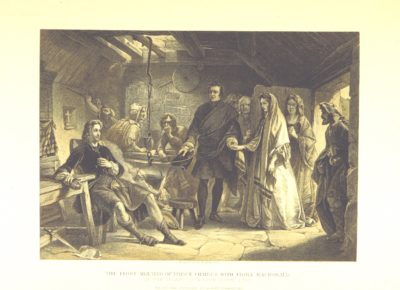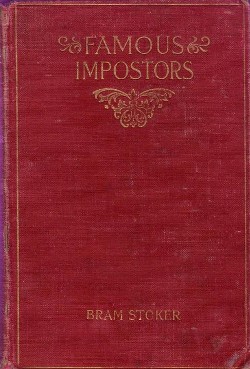Multiple identities in the Georgian period
Samantha Callaghan, Metadata Analyst, King’s Digital Laboratory

The first meeting of Prince Charles with Flora McDonald in the Island of South Uist. 1747.
Engraved by R. Anderson
To support collaborative work on the Georgian Papers, a Collaborative Workspace for the Programme is currently under development by King’s Digital Lab. The Workspace aggregates images, catalogue records and transcriptions and offers additional ways to augment the metadata provided by the Royal Archives. Augmentation is achieved through subject indexing, and the creation of person and organisation records known as name authority files.
‘Traditional’ name authority files are generally used in catalogues to:
- Control for spelling – ‘non-standard’ names point to a preferred name;
- Assist in disambiguation using birth and death dates; and,
- Link items in the catalogue, books, manuscripts, letters, and so on to a particular person or organisation as the author, publisher, printer.
Encoded Archival Context for Corporate Bodies, Persons, and Families (EAC-CPF), the metadata standard chosen for the Workspace, allows for all these functions but also allows for much more detailed context to be included. What other names were used and when; biographical or administrative information; a person’s birth and death dates, an organisation’s establishment and disestablishment dates, events of significance and much more. One of the most important functions offered through the use of this metadata standard is our ability to capture the relationships between various people and organisations, which is especially important due to the complex familial and other relationships that existed both within and outside the Royal Household.
The standard does provide guidance on its implementation but at a general level which is less useful when determining how to create name authority files for those who hold multiple identities. It does have the required elements, however, to enable us to create such files and thus we have taken the opportunity to investigate how these might best be used.
Scope
Within the context of the Georgian Papers Programme, I have explored the capture and encoding of those individuals who may be referenced in the papers who held multiple identities. Whilst it was common for the royal family and others to hold, use and be referred to by different names or titles they were not considered in this analysis to be instances of entities who held multiple identities. OED defines identity as, “who or what a person or thing is; a distinct impression of a single person or thing presented to or perceived by others; a set of characteristics or a description that distinguishes a person or thing from others.” [emphasis added]; members of the royal family are still recognised as the same person even when they receive a new title.
There are, however, examples of other individuals who did hold multiple identities and the work funded by the Marc Fitch Fund allowed for the exploration of how the contextual information for such individuals could be effectively captured.
The test set of entities collated includes individuals in disguise, scam artists, a ‘reborn’ Quaker, spies, a large contingent of women across Europe who joined armies as men (for various reasons), individuals who could be considered transgender, actors in particular roles (as a test case, Mary Robinson as Perdita) as well as infant actors. Not all entities are yet proven to be mentioned in the Georgian papers (a significant number of which are still uncatalogued) but as many were subjects of gossip across the continent and in newspapers there is a strong probability that, like Mary Toft and the birthing of rabbits story, they will be referenced.
Methodology
The process under which this work was undertaken was as follows:
- Collating of a test set of entities from those individuals suggested by colleagues and research fellows, Wikipedia and articles such as ‘Female Husbands’, Community and Courts in the Eighteenth Century by Caroline Derry
- Encoding name authority files for entities
- Recording difficulties where encountered and lessons learned with relation to encoding in EAC-CPF
The lessons learned here will be used when developing the metadata creation documentation for the Collaborative Workspace. This documentation will be shared firstly with the scholarly community of the Georgian Papers Programme for feedback once it is created and to ensure it is fit for purpose for the editing work to be undertaken on the Workspace. Secondly, it will be shared beyond the Programme and particularly with the now growing number of 18th century editorial projects linked to the Programme.
Of the 40 entities originally identified, 32 proved to be individuals with known multiple identities. Four of those with unknown multiple identities were spies where their other identities were unknown; three were individuals assigned female at birth who lived as men for at least some time for which we only know one of their identities; and lastly, one individual could be considered to have multiple genders over time, rather than multiple identities. Examples of individuals who we know are referenced and for whom name authorities have been included are: Bonnie Prince Charlie, who assumed an identity of an Irish washerwoman, Betty Burke, in June 1746 as he fled the British Isles after the Battle of Culloden; Chevalier d’Éon, a French spy; and Mary Robinson, actress and mistress of George IV when he was Prince of Wales.

Mary East is referenced in Bram Stoker’s Famous Imposters.
Issues
The most common difficulties encountered in such work included:
- Finding enough accessible information which is of relatively reliable quality to provide metadata especially in relation to spies but also with less well-known individuals. A frequent issue is how to disambiguate individuals based on diverse sources with differing information
- Achieving certainty, beyond dates of birth and death, about when an identity was assumed or taken often presented difficulties
- How do you capture use dates for names that were discarded and then taken up again, sometimes decades later as was the case with Mary East?
- Uncertainty in dates overall was also a factor but this is a difficulty very common to name authority work and is frequently addressed through the use of putative dates based on context
- Understanding what might be considered a different identity and what might not. For example, Chevalier d’Éon held multiple identities as a spy but also changed their gender expression in later life.
- The time taken to encode name authority files in XML. As the Collaborative Workspace is still being tested, any metadata I added may be removed as part of the testing process and thus it made sense to capture the metadata in XML in the meantime.
Lessons Learned
There were a number of lessons learned:
- Name authority file work of this kind is especially time consuming in comparison to those individuals who held a singular identity, even those who aren’t as well known;
- Definitions of what constitutes an identity are not necessarily consistent and we will need to develop robust definitions of our own to include in our metadata creation guidance; and,
- Examples and guidance will need to be given when choosing a mechanism to capture some context based on the information available and its quality.
Conclusions
On the issue of how best to capture contextual information in EAC-CPF it has become clear that much depends on the nature and the extent of the information available. If it relates to a particular place or specific events, place and chronology fields can be used. If these specifics are unavailable, context can be included in the narrative form of a biography, particularly so when little information is available and the context of the information needs to be referenced.
This work has been invaluable in allowing us to test the EAC-CPF standard which has the required elements to support the creation of name authority files for such individuals but only very general information about how to do so. This test has proven that EAC-CPF can encompass the capture of context for individuals with multiple identities in the Georgian Period. Furthermore, it does not require a metadata creator to use non-conformant cataloguing practice that might have been required by a more restrictive, less encompassing standard to include such contextual information.
The name authority files created through this work will prove to be a very useful source to provide guidance to the scholarly community of the Programme to assist them in creating and editing name authority files themselves.
Undertaking the creation of these name authority files at the same time that the editing interface for the Collaborative Workspace was being developed was also especially helpful in framing thinking around editing records. The Workspace has to be able to present an editor with a clear, clean interface that provides fields to enter the range of contextual information that is attached to entities with multiple identities without confusing the user. I have been able to directly give feedback to the UI/UX designer attached to the Workspace to assist her with her work.
